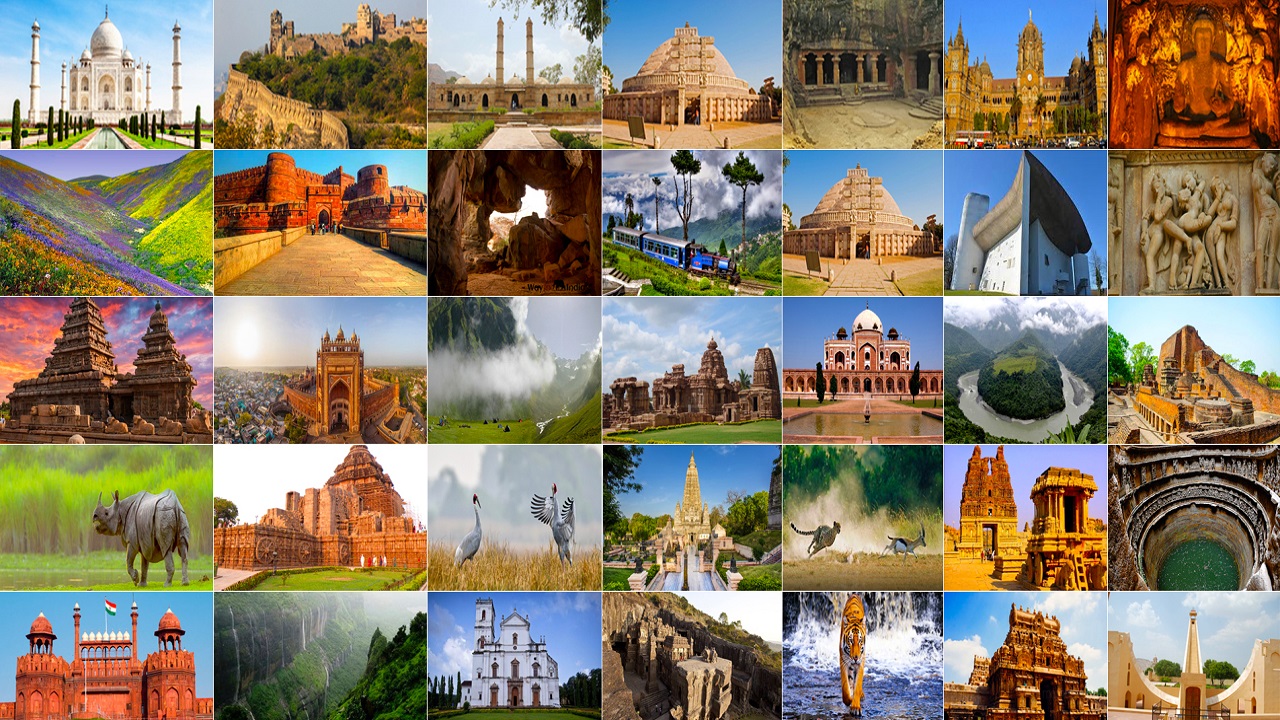India’s Architectural Heritage: Bridging Cultural Legacy and Climate Adaptation
Context:
India’s architectural heritage is not only a testament to its cultural legacy but also holds valuable insights into sustainable and climate-responsive construction practices. In the present context of rising climate risks, heritage structures are being increasingly recognized for their contribution to building resilient urban environments. India has 43 UNESCO World Heritage Sites, each representing diverse architectural traditions, climatic adaptations, and sustainable practices. By understanding these structures, cities can integrate time-tested solutions to tackle challenges like heatwaves, floods, and urban heat islands.
Key Features of India’s Architectural Heritage
India’s architectural heritage reflects a rich blend of building styles, regional influences, and historical evolution across centuries. It is characterized by both monumental and vernacular structures that were often designed with sensitivity to local climates and materials.
Some key features include:
-
A combination of ancient, medieval, Mughal, colonial, and regional architectural styles, reflecting cultural syncretism.
-
Rock-cut architecture as seen in the Ajanta and Ellora Caves in Maharashtra, showcasing intricate carvings and designs created directly into stone. These structures maintain cooler interiors through their design and materiality.
-
Temple architecture with distinct regional styles:
-
Nagara style (North India) marked by the rising shikhara; a prominent example is the Kandariya Mahadev Temple in Khajuraho, Madhya Pradesh.
-
Dravidian style (South India) characterized by towering gopurams and expansive mandapas, as seen in the Brihadeeswara Temple in Thanjavur, Tamil Nadu.
-
Vesara style blending both traditions, visible in Karnataka’s temples.
-
-
Mughal architecture blending Islamic and Indian elements, known for symmetry and marble construction, exemplified by the Taj Mahal in Agra and Red Fort in Delhi.
-
Forts and palaces like the Agra Fort and Mysore Palace, representing defensive as well as ceremonial functions.
-
The Indo-Saracenic style that emerged during British colonial rule, combining Indo-Islamic and European features, with the Victoria Memorial in Kolkata as a notable example.
These structures often incorporated thick walls, shaded spaces, courtyards, jalis, and verandas, making them inherently responsive to local climates.
Impacts of Urbanization on Heritage Infrastructure
Urbanization in India has led to several challenges for heritage structures. Some major impacts are:
-
Abandonment of historic urban cores as economic and social activities shifted to new urban centers, leaving old towns either deserted or overcrowded beyond their capacity.
-
Loss of identity and cultural erasure due to large-scale construction, often replacing historic precincts with modern developments.
-
Demolition and encroachment of heritage structures to accommodate new infrastructure projects, leading to permanent loss of cultural assets.
-
Environmental deterioration caused by increased air pollution, leading to faster degradation of heritage materials such as stone and marble. The Taj Mahal’s yellowing marble due to pollution is a notable example.
-
Social displacement and disruption of communities traditionally associated with heritage sites, threatening intangible cultural heritage linked to place and practice.
-
Alteration of the built heritage landscape, as modern developments introduce incompatible structures that overshadow or fragment the historical character.
-
Loss of climate-responsive design principles, as contemporary urban forms prioritize uniformity over context-specific, climatically adapted architecture.
Role of Architectural Heritage in Climate-Resilient Cities
Heritage structures offer practical strategies to enhance urban resilience in the face of climate challenges. Some important aspects include:
-
Many heritage buildings were designed with natural ventilation, thermal mass, shaded courtyards, and passive cooling techniques that reduce reliance on artificial cooling.
-
Features like thinnai (a semi-open porch in South Indian homes) create comfortable transition spaces that provide shade, facilitate social interaction, and reduce heat exposure.
-
Water management systems such as stepwells, tanks, rainwater harvesting, and greywater reuse were integral to historic urban planning. A significant example is the Bhuj Historic Water System in Gujarat, which showcased decentralized and efficient water management.
-
In flood-prone regions, heritage buildings often employed elevated foundations and flood-resistant materials, contributing to structural resilience.
-
The revival of heritage precincts in Rajasthan has shown that integrating heritage-based solutions can address natural disasters, heatwaves, and other climate risks with minimal investment, making them cost-effective and sustainable approaches.
Government Initiatives for Heritage Rejuvenation
Recognizing the importance of heritage, several initiatives have been launched:
-
HRIDAY (Heritage City Development and Augmentation Yojana) aims at holistic development of heritage cities by improving infrastructure, tourism, and cultural vibrancy.
-
Adopt a Heritage encourages private and public stakeholders to participate in the maintenance and enhancement of heritage sites.
-
PRASAD (Pilgrimage Rejuvenation and Spiritual Augmentation Drive) focuses on upgrading amenities and infrastructure at pilgrimage centers to promote tourism and preserve spiritual heritage.
Way Forward
The United Nations 2030 Agenda for Sustainable Development acknowledges the critical role of heritage in promoting sustainable, resilient, and inclusive urban growth. For India, this offers an opportunity to align urban planning with cultural preservation and climate action.
A reimagination of heritage cities is necessary, involving collaboration between planning authorities, local communities, and cultural institutions. The example of the Kochi-Muziris Biennale, where a medieval town was transformed into a vibrant cultural space, shows how heritage revival can foster economic and cultural renewal.
Future strategies could include adaptive reuse of heritage buildings for homestays, community spaces, or cultural hubs, enabling functional preservation while meeting contemporary needs. Cities like Jodhpur’s Blue City demonstrate how heritage homes can be conserved through integration into modern urban life.
Integrating green spaces and heritage-based urban design can help mitigate urban heat islands, improve air quality, and promote livability. Appropriate guidelines and policies by metropolitan authorities are essential to ensure that heritage buildings are protected while being made relevant for younger generations.
Conclusion
India’s architectural heritage is not only a cultural asset but also a repository of sustainable design knowledge. Reviving and integrating heritage into modern urban frameworks can address climate risks, enhance urban resilience, and preserve cultural identity. By valuing both tradition and innovation, heritage-based solutions can guide India toward sustainable, inclusive, and climate-resilient cities.




Comments (0)